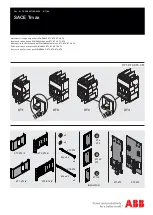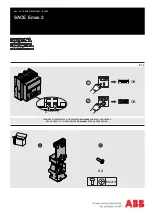
Instruction Book
Page 52
Effective: May 2016
For more information visit:
www.Eaton.com
IB131017EN
6-6 INSULATION
In VCP-TL and VCP-TRL circuit breakers, insulation
maintenance primarily consists of keeping all
insulating surfaces clean. This can be done by wiping
off all insulating surfaces with a dry lint free cloth or dry
paper towel. In case there is any tightly adhering dirt
that will not come off by wiping, it can be removed with
a mild solvent or distilled water. Be sure that the
surfaces are dry before placing the breaker in service.
If a solvent is required to cut dirt, use Stoddard's
Solvent (EATON 55812CA) or commercial equivalent.
Secondary control wiring requires inspection for
tightness of all connections and damage to insulation.
6-7 INSULATION INTEGRITY CHECK
Primary Circuit: The integrity of primary insulation
may be checked by the AC high potential test. The
test volt-age depends upon the maximum rated
voltage of the breaker. For the breakers rated 5.0kV,
12kV and 15.0 kV, the test voltages are 15kV, 21 kV
and 27 kV rms respectively. Conduct the test as
follows:
Close the breaker. Connect the high potential lead of
the test machine to one of the poles of the breaker.
Connect the remaining poles and breaker frame to
ground. Start the machine with output potential at
zero and increase to the test voltage. Maintain the
test volt-age for one minute. Repeat for the
remaining poles. Successful withstand indicates
satisfactory insulation strength of the primary circuit.
If a DC high potential machine is used, make
certain that the peak voltage does not exceed the
peak of the corresponding AC RMS test voltage.
Secondary Circuit:
Isolate the motor by pulling apart
the two insulated quick disconnecting terminals in the
two motor leads provided for this purpose. Connect
all points of the secondary disconnect pins with a
shooting wire. Connect this wire to the high potential
lead of the test machine. Ground the breaker frame.
Starting with zero, increase the voltage to 1500 volts
rms. Maintain the voltage for one minute. Successful
withstand indicates satisfactory insulation strength of
the secondary control circuit. Remove the shooting
wire and reconnect the motor leads.
6-8 PRIMARY CIRCUIT RESISTANCE CHECK
Since the main contacts are inside the vacuum
chamber, they remain clean and require no
maintenance at any time. If desired, the DC
resistance of the primary circuit may be measured as
follows: close the breaker, pass at least 100 amps DC
current through the breaker. With the low resistance
instrument, measure resistance
across the studs on the breaker side of the disconnect
for each pole. The resistance should not exceed the
values shown in Table
6.3.
6-9 MECHANISM CHECK
Make a careful visual inspection of the mechanism for
any loose parts such as bolts, nuts, pins and rings.
Check for excessive wear or damage to the breaker
components. Operate the breaker several times
manually and electrically. Check the closing and
opening times to verify that they are in accordance with
the limits in paragraph 5-4.1.
6-10 LUBRICATION
Maintenance of these circuit breakers and cassettes
consists mainly of keeping them clean with a
minimal amount of lubrication recommended. VCP-T
and VCPTR circuit breakers should be lubricated
every 3 years or 2000 operations with a high quality
10W30 motor oil and/or magna-lube G Teflon grease
C-H #53701 AI as indicated in Figure
6-5.
As
required for smooth operation, lubricate the drawout
cassette also with a high quality 10W30 motor oil
and/or magna-lube G Teflon grease C-H #53701AI
as indicated in Figure
6-6.
Table 6.3 Typical Resistance Measurements
Rated Continuous
Current (amperes)
Resistance
(microohms)
600
800
1200
1600
46
44
39
36
6-11 TROUBLESHOOTING
Refer to Table
6.4
for troubleshooting suggestions. It
will help to determine the probable causes of simple
circuit breaker problems and possible corrective
actions. If the problem cannot be resolved with the
aid of this guide, contact the EATON service center
for more in-depth assistance.






































